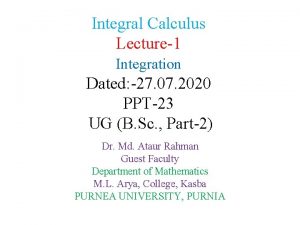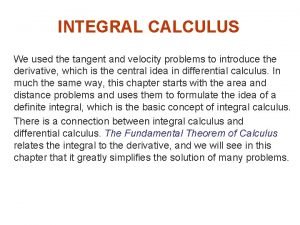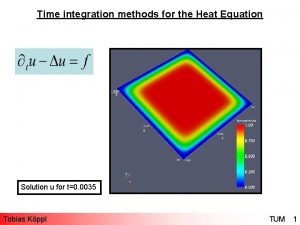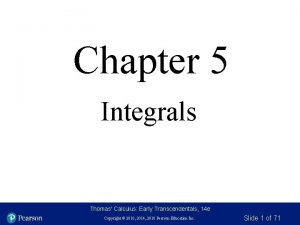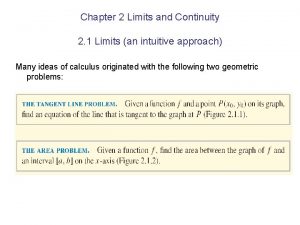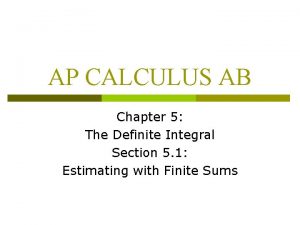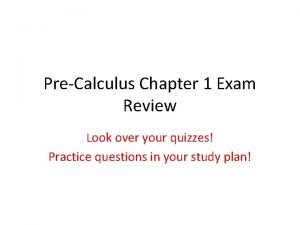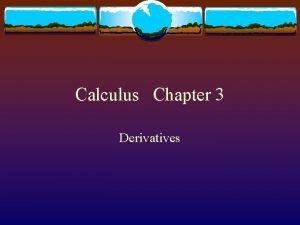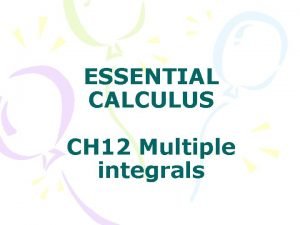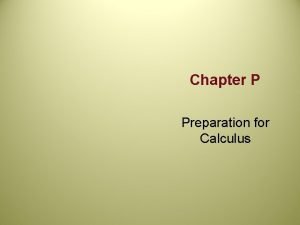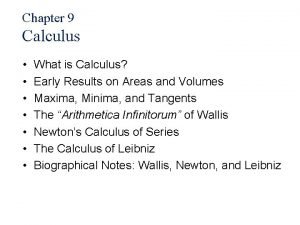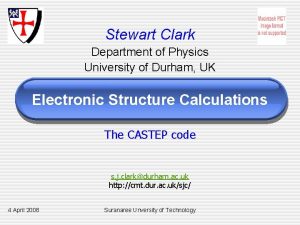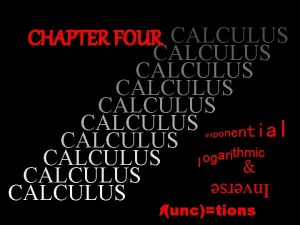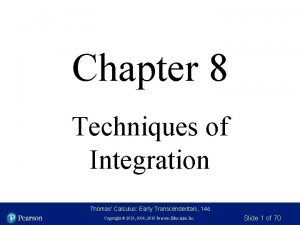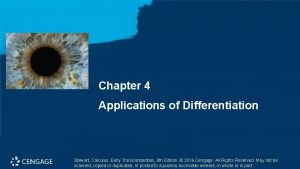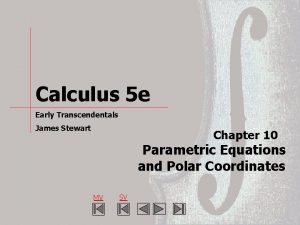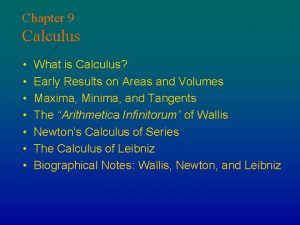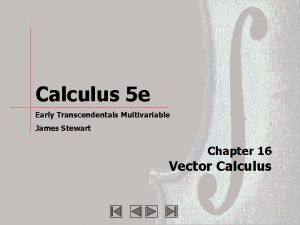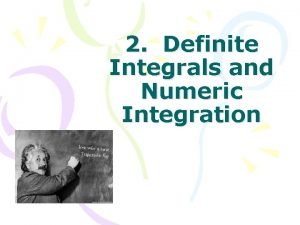Chapter 7 Techniques of Integration Stewart Calculus Early


























- Slides: 26

Chapter 7 Techniques of Integration Stewart, Calculus: Early Transcendentals, 8 th Edition. © 2016 Cengage. All Rights Reserved. May not be scanned, copied or duplicated, or posted to a publicly accessible website, in whole or in part.

7. 8 Improper Integrals Stewart, Calculus: Early Transcendentals, 8 th Edition. © 2016 Cengage. All Rights Reserved. May not be scanned, copied or duplicated, or posted to a publicly accessible website, in whole or in part.

Improper Integrals In this section we extend the concept of a definite integral to the case where the interval is infinite and also to the case where f has an infinite discontinuity in [a, b]. In either case the integral is called an improper integral. Stewart, Calculus: Early Transcendentals, 8 th Edition. © 2016 Cengage. All Rights Reserved. May not be scanned, copied or duplicated, or posted to a publicly accessible website, in whole or in part.

Type 1: Infinite Intervals Stewart, Calculus: Early Transcendentals, 8 th Edition. © 2016 Cengage. All Rights Reserved. May not be scanned, copied or duplicated, or posted to a publicly accessible website, in whole or in part.

Type 1: Infinite Intervals (1 of 7) Consider the infinite region S that lies under the curve above the x-axis, and to the right of the line x = 1. You might think that, since S is infinite in extent, its area must be infinite, but let’s take a closer look. The area of the part of S that lies to the left of the line x = t (shaded in Figure 1) is Figure 1 Stewart, Calculus: Early Transcendentals, 8 th Edition. © 2016 Cengage. All Rights Reserved. May not be scanned, copied or duplicated, or posted to a publicly accessible website, in whole or in part.

Type 1: Infinite Intervals (2 of 7) Notice that A(t) < 1 no matter how large t is chosen. We also observe that The area of the shaded region approaches 1 as t → ∞ (see Figure 2), so we say that the area of the infinite region S is equal to 1 and we write Figure 2 Stewart, Calculus: Early Transcendentals, 8 th Edition. © 2016 Cengage. All Rights Reserved. May not be scanned, copied or duplicated, or posted to a publicly accessible website, in whole or in part.

Type 1: Infinite Intervals (3 of 7) Using this example as a guide, we define the integral of f over an infinite interval as the limit of integrals over finite intervals. 1 Definition of an Improper Integral of Type 1 (a) If exists for every number t ≥ a, then provided this limit exists (as a finite number). (b) If exists for every number t ≤ b, then provided this limit exists (as a finite number). Stewart, Calculus: Early Transcendentals, 8 th Edition. © 2016 Cengage. All Rights Reserved. May not be scanned, copied or duplicated, or posted to a publicly accessible website, in whole or in part.

Type 1: Infinite Intervals (4 of 7) The improper integrals are called convergent if the corresponding limit exists and divergent if the limit does not exist. (c) If both are convergent, then we define In part (c) any real number a can be used (see Exercise 76). Stewart, Calculus: Early Transcendentals, 8 th Edition. © 2016 Cengage. All Rights Reserved. May not be scanned, copied or duplicated, or posted to a publicly accessible website, in whole or in part.

Type 1: Infinite Intervals (5 of 7) Any of the improper integrals in Definition 1 can be interpreted as an area provided that f is a positive function. For instance, in case (a) if f (x) ≥ 0 and the integral we define the area of the region This is appropriate because is convergent, then in Figure 3 to be is the limit as t → ∞ of the area under the graph of f from a to t. Figure 3 Stewart, Calculus: Early Transcendentals, 8 th Edition. © 2016 Cengage. All Rights Reserved. May not be scanned, copied or duplicated, or posted to a publicly accessible website, in whole or in part.

Example 1 Determine whether the integral is convergent or divergent. Solution: According to part (a) of Definition 1, we have The limit does not exist as a finite number and so the improper integral is divergent. Stewart, Calculus: Early Transcendentals, 8 th Edition. © 2016 Cengage. All Rights Reserved. May not be scanned, copied or duplicated, or posted to a publicly accessible website, in whole or in part.

Type 1: Infinite Intervals (6 of 7) Let’s compare the result of Example 1 with the example given at the beginning of this section: Figure 4 Figure 5 Stewart, Calculus: Early Transcendentals, 8 th Edition. © 2016 Cengage. All Rights Reserved. May not be scanned, copied or duplicated, or posted to a publicly accessible website, in whole or in part.

Type 1: Infinite Intervals (7 of 7) Geometrically, this says that although the curves similar for x > 0, the region under look very to the right of x = 1 (the shaded region in Figure 4) has finite area whereas the corresponding region under (in Figure 5) has infinite area. Note that both approaches 0 faster than The values of don’t decrease fast enough for its integral to have a finite value. We summarize this as follows: Stewart, Calculus: Early Transcendentals, 8 th Edition. © 2016 Cengage. All Rights Reserved. May not be scanned, copied or duplicated, or posted to a publicly accessible website, in whole or in part.

Type 2: Discontinuous Integrands Stewart, Calculus: Early Transcendentals, 8 th Edition. © 2016 Cengage. All Rights Reserved. May not be scanned, copied or duplicated, or posted to a publicly accessible website, in whole or in part.

Type 2: Discontinuous Integrands (1 of 4) Suppose that f is a positive continuous function defined on a finite interval but has a vertical asymptote at b. Let S be the unbounded region under the graph of f and above the x-axis between a and b. (For Type 1 integrals, the regions extended indefinitely in a horizontal direction. Here the region is infinite in a vertical direction. ) The area of the part of S between a and t (the shaded region in Figure 7) is Figure 7 Stewart, Calculus: Early Transcendentals, 8 th Edition. © 2016 Cengage. All Rights Reserved. May not be scanned, copied or duplicated, or posted to a publicly accessible website, in whole or in part.

Type 2: Discontinuous Integrands (2 of 4) If it happens that A(t) approaches a definite number A as then we say that the area of the region S is A and we write We use this equation to define an improper integral of Type 2 even when f is not a positive function, no matter what type of discontinuity f has at b. Stewart, Calculus: Early Transcendentals, 8 th Edition. © 2016 Cengage. All Rights Reserved. May not be scanned, copied or duplicated, or posted to a publicly accessible website, in whole or in part.

Type 2: Discontinuous Integrands (3 of 4) 3 Definition of an Improper Integral of Type 2 (a) If f is continuous on and is discontinuous at b, then if this limit exists (as a finite number). (b) If f is continuous on and is discontinuous at a, then if this limit exists (as a finite number). Stewart, Calculus: Early Transcendentals, 8 th Edition. © 2016 Cengage. All Rights Reserved. May not be scanned, copied or duplicated, or posted to a publicly accessible website, in whole or in part.

Type 2: Discontinuous Integrands (4 of 4) The improper integral is called convergent if the corresponding limit exists and divergent if the limit does not exist. (c) If f has a discontinuity at c, where a < c < b, and both are convergent, then we define Stewart, Calculus: Early Transcendentals, 8 th Edition. © 2016 Cengage. All Rights Reserved. May not be scanned, copied or duplicated, or posted to a publicly accessible website, in whole or in part.

Example 5 Find Solution: We note first that the given integral is improper because has the vertical asymptote x = 2. Since the infinite discontinuity occurs at the left endpoint of [2, 5], we use part (b) of Definition 3: Stewart, Calculus: Early Transcendentals, 8 th Edition. © 2016 Cengage. All Rights Reserved. May not be scanned, copied or duplicated, or posted to a publicly accessible website, in whole or in part.

Example 5 – Solution Thus the given improper integral is convergent and, since the integrand is positive, we can interpret the value of the integral as the area of the shaded region in Figure 10 Stewart, Calculus: Early Transcendentals, 8 th Edition. © 2016 Cengage. All Rights Reserved. May not be scanned, copied or duplicated, or posted to a publicly accessible website, in whole or in part.

A Comparison Test for Improper Integrals Stewart, Calculus: Early Transcendentals, 8 th Edition. © 2016 Cengage. All Rights Reserved. May not be scanned, copied or duplicated, or posted to a publicly accessible website, in whole or in part.

A Comparison Test for Improper Integrals (1 of 3) Sometimes it is impossible to find the exact value of an improper integral and yet it is important to know whether it is convergent or divergent. In such cases the following theorem is useful. Although we state it for Type 1 integrals, a similar theorem is true for Type 2 integrals. Comparison Theorem Suppose that f and g are continuous functions with f(x) ≥ g(x) ≥ 0 for x ≥ a. (a) If (b) If Stewart, Calculus: Early Transcendentals, 8 th Edition. © 2016 Cengage. All Rights Reserved. May not be scanned, copied or duplicated, or posted to a publicly accessible website, in whole or in part.

A Comparison Test for Improper Integrals (2 of 3) We omit the proof of the Comparison Theorem, but Figure 12 makes it seem plausible. Figure 12 If the area under the top curve y = f (x) is finite, then so is the area under the bottom curve y = g (x). Stewart, Calculus: Early Transcendentals, 8 th Edition. © 2016 Cengage. All Rights Reserved. May not be scanned, copied or duplicated, or posted to a publicly accessible website, in whole or in part.

A Comparison Test for Improper Integrals (3 of 3) If the area under y = g (x) is infinite, then so is the area under y = f (x). [Note that the reverse is not necessarily true: If is convergent, is divergent, may or may not be convergent, and if may or may not be divergent. ] Stewart, Calculus: Early Transcendentals, 8 th Edition. © 2016 Cengage. All Rights Reserved. May not be scanned, copied or duplicated, or posted to a publicly accessible website, in whole or in part.

Example 9 Show that is convergent. Solution: We can’t evaluate the integral directly because the antiderivative of is not an elementary function. We write and observe that the first integral on the right-hand side is just an ordinary definite integral. Stewart, Calculus: Early Transcendentals, 8 th Edition. © 2016 Cengage. All Rights Reserved. May not be scanned, copied or duplicated, or posted to a publicly accessible website, in whole or in part.

Example 9 – Solution (1 of 2) In the second integral we use the fact that for x 1 we have and therefore The integral of (See Figure 13. ) is easy to evaluate: Figure 13 Stewart, Calculus: Early Transcendentals, 8 th Edition. © 2016 Cengage. All Rights Reserved. May not be scanned, copied or duplicated, or posted to a publicly accessible website, in whole or in part.

Example 9 – Solution (2 of 2) Therefore, taking that It follows that in the Comparison Theorem, we see is convergent. Stewart, Calculus: Early Transcendentals, 8 th Edition. © 2016 Cengage. All Rights Reserved. May not be scanned, copied or duplicated, or posted to a publicly accessible website, in whole or in part.
 Stewart calculus chapter 11
Stewart calculus chapter 11 Integration by substitution ppt
Integration by substitution ppt Integral calculus formulas
Integral calculus formulas Chapter 7 techniques of integration
Chapter 7 techniques of integration Early cpr and early defibrillation can: *
Early cpr and early defibrillation can: * Forward integration and backward integration
Forward integration and backward integration Xiaomi bcg matrix
Xiaomi bcg matrix Simultaneous integration
Simultaneous integration Techniques of integration
Techniques of integration 7 techniques of integration
7 techniques of integration Explicit method is stable only if
Explicit method is stable only if Calculus chapter 5 integrals
Calculus chapter 5 integrals Limits
Limits Ap calculus chapter 5
Ap calculus chapter 5 Precalculus honors chapter 1 test
Precalculus honors chapter 1 test Calculus chapter 3
Calculus chapter 3 Calculus chapter 12
Calculus chapter 12 Chapter p preparation for calculus
Chapter p preparation for calculus What is calculus for
What is calculus for Fonctions et solutions techniques
Fonctions et solutions techniques Stewart clark durham
Stewart clark durham Compliance psychology
Compliance psychology Prueba de stewart holmes
Prueba de stewart holmes Selina stewart
Selina stewart Mr stewart physics
Mr stewart physics Paul cardall life and death
Paul cardall life and death Lily collins 2014
Lily collins 2014

